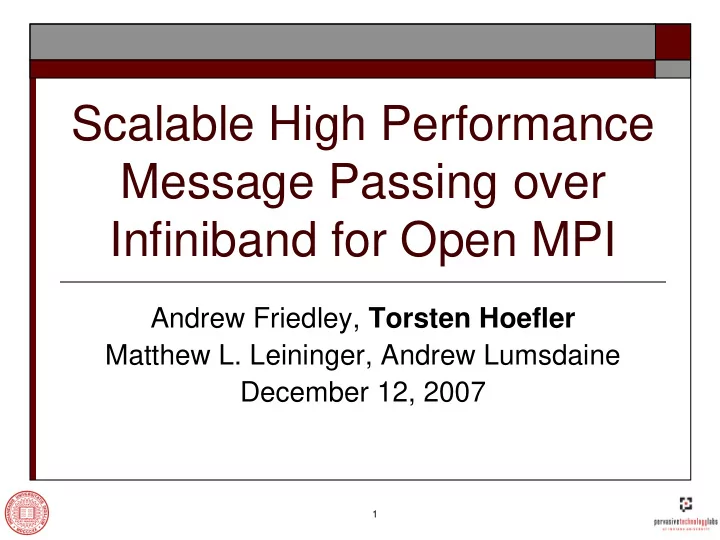

Scalable High Performance Message Passing over Infiniband for Open MPI Andrew Friedley, Torsten Hoefler Matthew L. Leininger, Andrew Lumsdaine December 12, 2007 1
Motivation MPI is the de facto standard for HPC InfiniBand growing in popularity Particularly on large-scale clusters June 2005 Top500: 3% of machines November 2007 Top500: 24% of machines Clusters growing in size Thunderbird, 4,500 node InfiniBand 2
InfiniBand (IB) Architecture Queue Pair concept (QP) Send a message by posting work to a queue Post receive buffers to a queue for use by hardware Completion Queue Signals local send completion Returns receive buffers filled with data Shared Receive Queue Multiple QPs share a single receive queue Reduces network resources 3
Reliable Connection (RC) Transport Traditional approach for MPI communication over InfiniBand Point-to-point connections Send/receive and RDMA semantics One queue pair per connection Out-of-band handshake required to establish Memory requirements scale with number of connections Memory buffer requirements reduced by using shared receive queue 4
Unreliable Datagram Transport Requires software (MPI) reliability protocol Memory-to-Memory, not HCA-to-HCA Message size limited to network MTU 2 kilobytes on current hardware Connectionless model No setup overhead One QP can communicate with any peer Except for address information, memory requirement is constant 5
Open MPI Modular Component Architecture Framework consists of many components Component is instantiated into modules 6
PML Components OB1 Implements MPI point-to-point semantics Fragmentation and scheduling of messages Optimized for performance in common use Data Reliability (DR) Extends OB1 with network fault tolerance Message reliability protocol Data checksumming 7
Byte Transport Layer (BTL) Components are interconnect specific TCP, shmem, GM, OpenIB, uDAPL, et. al. Send/Receive Semantics PML fragments, not MPI messages RDMA Put/Get Semantics Optional – not always supported! 8
Byte Transport Layer (BTL) Entirely Asynchronous Blocking is not allowed Progress made via polling Lazy connection establishment Point-to-point connections established as needed Option to multiplex physical interfaces in one module, or to provide many modules No MPI semantics Simple, peer-to-peer data transfer operations 9
UD BTL Implementation RDMA not supported Use with DR PML Receiver buffer management Messages dropped if no buffers available Allocate a large, static pool No flow control in current design 10
Queue Pair Striping Splitting sends across multiple queue pairs increases bandwidth Receive buffers still posted to one QP 11
Results LLNL Atlas 1,152 quad dual-core (8 core) nodes InfiniBand DDR network Open MPI trunk r16080 Code publicly available since June 2007 UD results with both DR and OB1 Compare DR reliability overhead RC with and without Shared Receive Queue 12
NetPIPE Latency 13
NetPIPE Bandwidth 14
Allconn Benchmark Each MPI process sends a 0-byte message to every other process Done in a ring-like fashion to balance load Measures time required to establish connections between all peers For connection-oriented networks, at least UD should only reflect time required to send messages – no establishment overhead 15
Allconn Startup Overhead 16
Allconn Memory Overhead 17
ABINIT 18
SMG2000 Solver 19
SMG2000 Solver Memory 20
Conclusion UD is an excellent alternative to RC Significantly reduced memory requirements More memory for the application Minimal startup/initialization overhead Helps with job turnaround on large, busy systems Advantage increases as scale increases Clusters will continue to increase in size DR-based reliability incurs penalty Minimal some some applications (ABINIT), significant for others (SMG2000) 21
Future Work Optimized reliability protocol in the BTL Initial implementation working right now Much lower latency impact Bandwidth optimization in progress Improved flow control & buffer management Hard problem 22
Flow Control Problems Lossy Network No guarantee flow control signals are received Probabilistic approaches are required Abstraction barrier PML hides packet loss from BTL Message storms are expected by PML, not BTL Throttling mechanisms Limited ability to control message rate Who do we notify when congestion occurs? 23
Flow Control Solutions Use throttle signals instead of absolute credit counts Maintain a moving average of receive completion rate Enable/disable endpoint striping to throttle message rate Use multicast to send throttle signals All peers receive information Scalable? 24
Recommend
More recommend